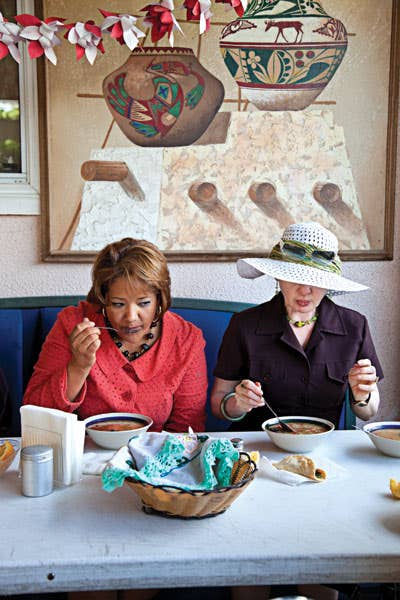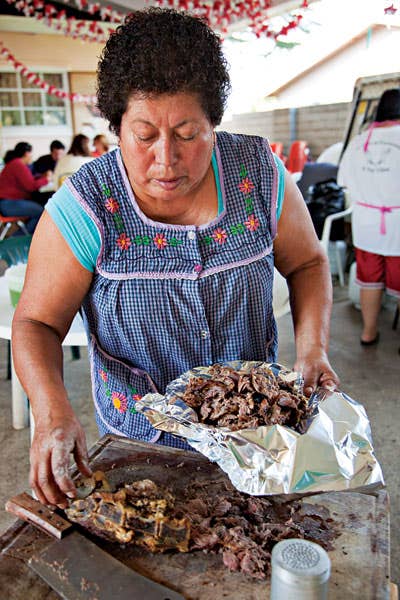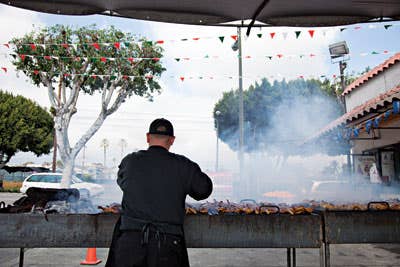
In East Los Angeles, Mexican families partake in the ritual of barbacoa, pit-smoked to tender sweetness by one amazing cook
Many an immigrant community has brought its own pit-cooking tradition to America. Mexico City's tacos al pastor, stuffed with spit-roast pork and eaten in Columbus, Ohio; sukhaar, Somalia's saucy, slow-roasted chicken, a hit in Charlotte, North Carolina; banh mixa xiu, barbecued pork heaped on baguettes found in Biloxi, Mississippi, and other cities with Vietnamese populations: Though the preparations vary, the effects are universal. Wherever it is found, pit-cooked meat links generations, wins elections, inspires obsession, incites feuds, and can be a near-mystical experience, as is the case for Tia Adelita, the patron saint of East Los Angeles County barbacoa, meat swathed in leaves from the maguey plant (a species of agave) and slow-cooked, in the style of the Mexican countryside, in a hole in the ground.
Tia Adelita is 55 years old and not sure why she, the ninth of ten siblings from Puebla, Mexico, is the only one in her family who absorbed the ritual that begins with lassoing a lamb and ends with lifting moist meat from the earth. She was never tutored in the art.
"My father was a farmer, famous for his barbacoa, but he shooed us away; he didn't want us near his pit. He didn't want us in the kitchen with our mother, either. He said that he wanted better things for his children," she says.

photo by Penny de los Santos
Tia Adelita and her barbacoa
It is just past dawn on a Sunday morning, and Tia Adelita (who asked that I not use her real name) is poised, iron shovel in hand, over the rectangular fire pit in her backyard. In her floral-print smock and tiny slippered feet, she is compact, almost fragile looking. Then, as if seized by a spirit, this grandmother of eight heaves the shovel deep into the burning logs four feet below her on the concrete floor of her cooking pit. Thwack! Grunt! Ash and sparks swarm upward like angry bees. After ten minutes, Tia Adelita is panting and sweating. She mops her brow with a tea towel.
"When my husband and I moved to California, in 1988, I knew nothing of cooking. I thought my children would be hungry," she said. "I did not know, but my hands knew." Thirty years later, washed in the oily waves of the kiln-like heat from her pit, she shakes her head, recalling the inexplicable. A dozen different moles, a remarkable pork adobo, a procession of the hallmarks of classic Mexican cuisine issued from her kitchen. She cannot explain how she knew what to do.
And when fellow Puebla expatriates spoke longingly of barbacoa, her response was equally atavistic. She directed her young sons to dig a pit and to line it with cinder blocks, then she shooed them away. Foraging for the huge chunks of encino (white oak) wood, the broad maguey leaves to cover the meat, the metal grates from discarded ovens, the scrap metal for covering the pit—this she did alone. Then she moved through the two-day ritual of tending the fire as if she'd been pit-roasting lamb forever. Her barbacoa was the same as her father's; her siblings were a little spooked. She was gobsmacked when the police arrived. "We lived in South Central LA then," she tells me. "The neighbors got scared when they saw smoke."

photo by Penny de los Santos
_ A vendor makes pollo asado over a wood fire_
Word spread. The after-church Sunday feast is, after all, a tradition among the area's Mexican community. Families dash from their double-parked cars to purchase pollo asado (grilled chicken) from sidewalk entrepreneurs. But in the diocese of barbacoa, these curbside vendors are mere chapels, while Tia Adelita is high church. People now arrive at her house by the carload on Sundays for pulled lamb, tortillas, salsa, guacamole, and bowls of soup that are cooked beneath the meat in the pit, redolent with its juices and thick with chickpeas and rice.
After 20 years of selling barbacoa while working housecleaning jobs during the week, she was able to move to a nicer house farther east, in the Avocado Heights section of the San Gabriel Valley. Set back from a leafy boulevard, her home is a midcentury ranch with a lavishly landscaped front yard. But the United States ends at the rear of the house. Her carport has been turned into a kitchen, and the backyard is a two-acre patch of Puebla. The trailers and cottages her children and grandchildren occupy are perched in the rutted mud. A barn is home to ponies and goats. As morning light masters the sky, a rooster crows.
Tia Adelita unrolls carpet samples (her former husband and several sons run a carpet-installation business) and tucks them over the door on her pit. The alchemy is now up to the lamb she chose and helped to butcher ("It must have a black face. Do not ask why I know this, but I know," she says), the broth and beans she assembled, the fire she tended. As the miracle takes shape over the next five hours, Tia Adelita and her children will make guacamole and salsa, pat out fresh tortillas, set tables. By the time the church bells toll, the aromas of smoke and tender lamb, of soup and tortillas cooking, will perfume the air, and the carport will be an unbroken link in a history of meals that Pueblans say stretches back to antiquity.
But, first, Tia Adelita uses two lengths of crowbar to fashion a crucifix and lays it tenderly over the smoke-stained carpet.
"For the lamb," she says. "Now there is nothing more I can do. You plan; you do what your hands know to do. The rest is faith."
_
_
Keep Reading
Continue to Next Story










